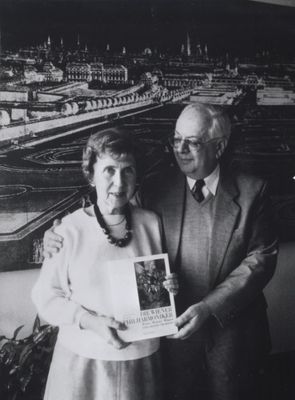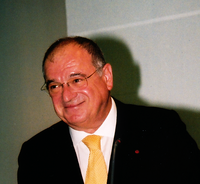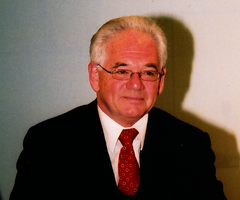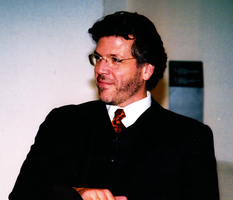The Founding of the Society and the Presidency of Erwin Ratz
The decisive initiative to found the International Gustav Mahler Society (IGMS) in 1955, a year that was significant for Austrian postwar history, came from the Vienna Philharmonic. Although this orchestra by no means had been free from anti-Semitic activities during the Nazi era, its commitment to the founding of the IGMS was of crucial importance for the subsequent international acceptance of Mahler’s music. Even ten years after the end of the Second World War, dealing with Mahler’s work was controversial and often continued to be determined by anti-Semitic resentments. Only a few internationally renowned orchestras and conductors championed his work and the number of performances of his symphonies and songs was limited, a situation that lasted well into the 1960s.
As early as June 3, 1945, less than four weeks after the end of the war, the Philharmoniker performed Mahler’s First Symphony under the direction of Robert Fanta and also bore the costs for the care of Mahler’s grave at the Grinzinger Friedhof. In May 1954 they asked Bruno Walter to take over the presidency of a Mahler Society that was to be founded. Although Walter answered affirmatively in principle, he suggested that an inquiry in this regard should first be sent to Gustav Mahler’s widow Alma Mahler. Alma Mahler’s letter to Hermann Obermeyer, the director of the Vienna Philharmonic, however was sobering. She accused both the orchestra and the Republic of Austria of reprehensible behavior towards Mahler and herself and rejected any participation in a Mahler Society. Nevertheless, the Philharmonic could not be dissuaded from their commitment. Ultimately, Alma Mahler changed her attitude and supported the IGMS in many ways, above all by agreeing to make all Mahler’s manuscripts in her possession available for microfilming, an essential prerequisite for the creation of a complete critical edition.
The IGMS was officially founded on November 11, 1955: Erwin Ratz was elected President, Alma Mahler Honorary Member and Bruno Walter Honorary President. Ratz (1898–1973) had been a student of Guido Adler, Arnold Schönberg (from 1917) and Anton Webern (from 1925), together with Schönberg and 18 other members of his circle of students and friends he had founded the Verein für musikalische Privataufführungen (Association for Private Musical Performances) in 1918 and taught from 1945 until his death in 1973 theory of form at the Academy/Hochschule for Music and Performing Arts in Vienna (as a Professor since 1957). The first board of the IGMS included important personalities from art and science such as Theodor W. Adorno, Ernst Krenek, Rafael Kubelík, Rudolf Mengelberg, Georg Solti, Eduard Reeser, and Donald Mitchell as well as – on the part of the Philharmonic – managing director Helmut Wobisch and chairman Hermann Obermeyer. An important initiative on the part of the Vienna Philharmonic during the founding period was the performance of Mahler’s Ninth Symphony on March 2 and 3, 1957 under the direction of Rafael Kubelík, during which the article “Aufgaben und Ziele der Internationalen Gustav Mahler Gesellschaft” (Tasks and Goals of the International Gustav Mahler Society) was published in the orchestra’s newsletter.
The early days of the IGMS coincided with a phase in which Mahler’s symphonies continued to be received very hesitantly. All the more it required a high level of commitment on the part of the IGMS, above all its President Erwin Ratz, who significantly promoted Mahler’s profile as a “pioneer for new music.” Ratz’s main interest was on the one hand the analytical examination of Mahler’s works, pursuing an approach committed to Schoenberg’s music-theoretical concepts, and on the other hand the establishment of a complete critical edition. Only this would ensure a solid scholarly study of the work and provide the basis for text-critical performances of Mahler’s œuvre. To a much lesser extent, Ratz was concerned with Mahler’s biography, a venture that was subsequently pursued primarily by Henry Louis de La Grange, Donald Mitchell, and Edward E. Reilly. This focus of the IGMS’s activities and the desire for an increase in the number of performances and thus a greater popularity of Mahler were reflected not least in the statutes of the IGMS: The “promotion of Gustav Mahler’s work through performances, production of records and other sound carriers, through stimulation of and support for scholarly work, by establishing ties to broadcasting companies and by hosting lectures” were listed as top priorities. In addition, it was considered necessary to establish a “comprehensive documentation of sources and literature” based on the model of the Beethoven archive in Bonn, a Mahler library, and a publication series in which important research relating to Mahler should be published. Ultimately, the project was pursued to preserve the places where Mahler worked, in particular the “composing huts”, and to make them accessible to an interested public. All this required a lot of time and energy as well as financial support, which in the beginning was only provided by membership fees from the founders, promotors, and members of the IGMS, but soon also by subsidies from both the Federal Ministry for Education and Art and the Cultural Office of the City of Vienna. At the same time, there was a gradual internationalization of Mahler research by foreign Mahler societies, with the founding of the Dutch Mahler Foundation (1956) being of particular importance.
Within the first two years after the founding of the IGMS, the stated objectives already led to a comprehensive archive of manuscripts and scores corrected by Mahler, an archive of sound recordings, and a library of around 1,500 titles. Ratz’s initiatives to create public awareness of Mahler’s work were also reflected in the awarding of the Golden Mahler Medal for special musical merits related to Mahler to important conductors such as Carl Schuricht and Eduard van Beinum. Radio productions of the Sixth and Seventh Symphonies were other important milestones in the late 1950s on the way to 1960, the anniversary year marking Mahler’s hundredth birthday.
The Anniversary Year 1960 and Its Consequences
This year undoubtedly and in many ways marked a decisive turning point in the hitherto rather reserved reception of Mahler. Mahler studies received a considerable boost by the publishing of Theodor W. Adorno’s monograph Mahler. Eine musikalische Physiognomik (Mahler.A Musical Physiognomy) in 1960, still a fundamental work of Mahler research. A comprehensive exhibition “Gustav Mahler and His Time” in the Vienna Secession enabled a broad audience to experience the life, work, and cultural environment of Mahler’s work. And the number of performances also increased considerably, in line with the IGMS’s aim of disseminating Mahler’s work. Of particular importance for the IGMS was the publication of the first volume of the Critical Complete Edition, the Seventh Symphony published by Bote & Bock, in which no fewer than 800 corrections were made to the first edition published in 1908. This was the starting signal for continuous work on the complete edition. In the four years that followed, no fewer than five more volumes were published: the Symphonies 4, 6 and 5, the Adagio of the Tenth Symphony, and Das Lied von der Erde.
The 1960s also brought a fundamental change of generations: the death of Bruno Walter (1962), Alma Mahler (1964), and Theodor W. Adorno (1969) marked a turning point, which, however, did not keep the IGMS from further pursuing its goal of creating a broad public awareness for Mahler’s work. Leonard Bernstein was awarded the Golden Mahler Medal for his complete recording of Mahler’s symphonies (1967). In the scientific field, significant new territory was entered with Kurt Blaukopf’s study Gustav Mahler oder der Zeitgenosse der Zukunft (Gustav Mahler, or the Contemporary of the Future), which was published in 1969.
The 1970s: Gottfried von Einem as the New President and New Premises
Probably the most decisive event of the following decade was the death of Erwin Ratz (1973), which meant a serious crisis for the IGMS. The fact that this was nevertheless quickly overcome is mainly due to three personalities: Karl Heinz Füssl as the new editor of the complete edition, Kurt Blaukopf as head of the extensive archive and the scientific work based on it, and finally the internationally renowned composer Gottfried von Einem as president the IGMS, who held this position for over 18 years.
A significant and highly necessary change of the society’s premises took place in autumn 1975. The purchase of an apartment at Wiedner Gürtel 6 in the fourth district of Vienna enabled the IGMS to adequately house its extensive materials. At the same time, this year meant an opening toward increasingly international activities. The News about Mahler Research (Nachrichten zur Mahler-Forschung), published by the society since 1976 in German and English, should be mentioned in particular. There are currently 75 issues of this journal. In addition, Kurt Blaukopf initiated an independent book series (Bibliothek der Internationalen Gustav Mahler Gesellschaft, Library of the International Gustav Mahler Society), the first two volumes of which were Edward R. Reilly’s monograph Gustav Mahler und Guido Adler (1978) and Eduard Reeser’s edition of letters Gustav Mahler und Holland (1980). After a long interruption due to lack of funding, the book series was continued with Andreas Michalek’s work „…schreiben sie Mahler keine dummen Briefe…“: Gustav Mahler und Rosa Papier (2013). In addition, Blaukopf’s documentary biography Mahler was published, in which numerous letter documents and, with 365 illustrations, the most comprehensive pictorial documentation at that point were published for the first time.
Financially, too, the 1970s were an encouraging decade. On the one hand, the financial resources of the Viennese Gustav Mahler Denkmal Verein (Gustav Mahler Memorial Association) for an unrealized memorial benefited the society. Leonard Bernstein and the Vienna Philharmonic also proved to be particularly important promotors, who left the net profit from performances of the Eighth Symphony in the Vienna Konzerthaus to the IGMS. All of this led to a significantly intensified activity, in which not least the numerous research initiatives of the IGMS played a significant role. In 1979, the IGMS, in cooperation with the Österreichische Gesellschaft für Musik (Austrian Society for Music), organized an International Gustav Mahler Colloquium – the first Mahler Conference ever to be held in Vienna. Just a few months later, a large-scale Gustav Mahler exhibition curated by Rudolf Stephan took place at the Düsseldorf Heinrich Heine Institute.
The 1980s: The Rescue of the Composing Huts
The numerous important impulses of the 1970s continued unabated in the 1980s. In 1980, after 20 years, already twelve volumes of the Complete Critical Edition (Kritische Gesamtausgabe) were available. With the first edition of the correspondence between Mahler and Richard Strauss, Herta Blaukopf presented significant source material for further research. A pioneering work was Herta Blaukopf’s revised new edition of Gustav Mahler, Briefe, published in 1982 (expanded by 30 letters in a new edition in 1996), probably the most important compendium of Mahler’s rich correspondence. The honors for important artists already made in the early days of the IGMS were now also extended to include important protagonists of Mahler research. The Golden Mahler Medal was awarded among others to Christa Ludwig, Dietrich Fischer-Dieskau, Carlo Maria Giulini, the Vienna Philharmonic, as well as to Alice and Franz Strauss for their essential assistance for the Mahler-Strauss letter edition and to the Mahler scholars Donald Mitchell (1987), Edward R. Reilly (1997), Henry-Louis de La Grange (2005), and Knud Martner (2007).
The activities of the IGMS increasingly focused on the Mahler memorials, especially the composing huts in Steinbach am Attersee, Maiernigg am Wörthersee, and Toblach, which proved to be extremely complicated to maintain. Only after protracted and sometimes tough negotiations was it possible to place these three essential sites of Mahler’s compositional work under monument protection and to restore them as places of remembrance and commemoration of one of the most important composers of the time around 1900. In October 1981, a commemorative plaque was placed on Mahler’s Viennese apartment at Auenbruggergasse 2 in the third district. On May 4, 1985, the composing hut in Steinbach was ceremoniously opened, featuring documentation from the IGMS’s holdings about Mahler’s work there. Just one year later, on July 7, 1986, the composing hut in Maiernigg was opened, and in 1992 finally the one in Dobbiaco/Toblach, in which Mahler composed Das Lied von der Erde, the Ninth and the unfinished Tenth Symphony. The founding of the annual Gustav Mahler Music Weeks at Toblach by a committee in 1981 formed the starting point of an initiative that is now known worldwide. The music weeks have been taking place in the Cultural Centre Grand Hotel Toblach since 1991 and feature orchestra and chamber concerts, exhibitions, and scientific events. In 2021, the Gustav Mahler Research Centre was set up as a collaborative project between the Gustav Mahler Toblach-Dolomiten Foundation and the Institute for Musicology at the University of Innsbruck, headed by Federico Celestini.
The 1990s: On the Way to the Digital Archive
The early 1990s were marked by two major changes or turning points for the IGMS. Gottfried von Einem, President of the IGMS since 1973, resigned from his position as President of the IGMS at the General Assembly in 1991 for reasons of age. The previous Vice President and Secretary General of the Vienna Symphony Orchestra, Rainer Bischof, was elected his successor and held this position until 2015. Just one year later, with the unexpected death of Karlheinz Füssl in 1992, there was another turning point. Füssl was succeeded by Reinhold Kubik as the new director of the complete edition, in which during this decade further important volumes were published: the three-movement original version of Das klagende Lied (1997, revised 2011) as well as the Wunderhornlieder for voice and piano (1993, new edition 2008) and for voice and orchestra (1998, new edition 2010). In 1997, to mark the centenary of Mahler’s appointment as director of the Vienna Hofoper, a comprehensive exhibition entitled Die Ära Gustav Mahler (The Era of Gustav Mahler), curated by the IGMS and the Theatermuseum Vienna, took place.
In the years 1994/95 the IGMS launched the phase of digitization. Gradually, the holdings of the library and archive were made accessible in electronic form and a website for the society was created by Frank Fanning. From 2001 to 2021, Fanning continued to expand and modernize this website (https://gustav-mahler.org) and was awarded the Golden Mahler Medal for his services to the IGMS in 2022.
The Years From 2000: The New Critical Complete Edition and New Research Findings
The philological standards for complete critical editions have changed significantly since the publication of the first volume of the Seventh Symphony in 1960. While in the early days it was a question of quickly creating a reasonably reliable text basis (with usually very brief critical reports), the later volumes contain much more precise and extensive comparisons of the sources as basis of the edition. This necessitated the realization of a New Critical Complete Edition (Neue Kritische Gesamtausgabe, NKA), which differs from the earlier volumes in that it contains newly produced musical notation and new performance materials as well as detailed accompanying texts. By 2010, the Second Symphony, the Sixth Symphony, and the revised editions of the Wunderhornlieder in the versions with piano (2008) and orchestra (2010) were published, followed by the Seventh Symphony (2012) and the extended edition of the piano version of Das Lied von der Erde (2012). Reinhold Kubik resigned as director in 2012, and since then Renate Stark-Voit and Stephen Hefling have been in charge of the New Critical Complete Edition. In 2019, the volume of the symphonic tone poem Titan (an early version of the First Symphony), edited by Stephen Hefling, received the “Best Edition Award.” The new edition of the Fourth Symphony, edited by Renate Stark-Voit, was completed at the end of 2021 and has since been performed several times. This volume also received the “Best Edition Award” in April 2022. Further volumes are in preparation.
The clear focus of activities with regard to the commemorative years 2010 (on the 150th anniversary of Mahler's birth) and 2011 (on the hundredth anniversary of Mahler's death) among others led to an extensive exhibition “leider bleibe ich ein eingefleischter Wiener” – Gustav Mahler und Wien (“unfortunately, I remain a die-hard Viennese” – Gustav Mahler and Vienna) in the Österreichische Theatermuseum. From a scientific point of view, further new accents were set. The two international symposiums on musical instruments and performance practice of Gustav Mahler’s time (published in print in 2007 and 2021) opened up important new insights into the sound of Mahler’s works during his lifetime.
In 2015, Rainer Bischof ended his 24-year tenure as President of the IGMS. He was succeeded by Christian Meyer. During Meyer’s presidency, the anniversary celebration “60 Years of IGMS” took place on October 30, 2015 in the Glass Hall of the Musikverein, which was decisively shaped by the artistic commitment of Thomas Hampson and the Wiener Virtuosen. Kammersänger Thomas Hampson, to whom the IGMS owes decisive funding and impulses, was Vice President of the IGMS until 2019 and has been artistic advisor to the board since that year.
At the General Assembly on June 28, 2019, a new board was elected with Peter Revers as President and Barbara Boisits as Vice President. After the board election in 2023, Christian Utz took over the office of President, Peter Revers that of Vice President and Barbara Boisits that of Treasurer. The other members of the current board are Thomas Glaser (Secretary), Morten Solvik, Meike Wilfing-Albrecht, Stephen Hefling, Renate Stark-Voit, Federico Celestini, and Alexander Steinberger, second violinist and vice chairman of the Vienna Philharmonic. Significant initiatives in recent years include the fundamental renewal of the IGMS website and the creation of a digital work catalogue of Gustav Mahler’s works (GMW) based on methods developed in the Digital Humanities as a cooperation project of the IGMS with the Austrian Academy of Sciences and the University of Innsbruck (“Mahler Online”). Securing and digitizing the IGMS’s archive holdings is another focus of current activities. In addition, the importance of the Vienna Philharmonic in the context of the governing bodies of the IGMS has increased significantly in recent years. In addition to Alexander Steinberger, the IGMS was able to win cellist Bernhard Hedenborg as treasurer and retired solo cellist Franz Bartolomey as a member of the advisory board. Clemens Hellsberg and Werner Resel had already worked as auditors for many years in earlier periods.
With the foundation of the Wissenschaftszentrum Gustav Mahler at the University of Music and Performing Arts Vienna, another important cooperation was inaugurated – in addition to the continuous cooperation with the Toblach Gustav Mahler Research Center. The Wissenschaftszentrum was inaugurated in June 2022 with the large-scale international symposium Voices of History – History of Voices with a particular focus on the area of Mahler performance history. In this context, too, a close cooperation with the Vienna Philharmonic featured the performance of Erwin Stein’s chamber orchestra version of the first movement of Mahler’s Fourth Symphony by Vienna Philharmonic Academy members under the direction of the former principal violinist Josef Hell.
In the upcoming years, the International Gustav Mahler Society faces major challenges, since in addition to the technically demanding and time-consuming research and edition projects, the maintenance of the premises and a renewal of the technical equipment of the archive are of great urgency. However, chronic budget shortages are delaying the implementation of many of the projects currently in progress. The IGMS, which is now financed almost exclusively from membership fees and donations (with very little annual subsidies from the City of Vienna), continues to require great commitment from the board, advisory board, promotors, and members.
References
- Erich Wolfgang Partsch, “Zur Geschichte der Internationalen Gustav Mahler Gesellschaft.” In Gustav Mahler: Werk und Wirken. Vierzig Jahre Internationale Gustav Mahler Gesellschaft, edited by Erich Wolfgang Partsch. Vienna, 1996, 11–33.
- Reinhold Kubik, “The History of the International Gustav Mahler Society in Vienna and the Complete Critical Edition.” In The Cambridge Companion to Mahler, edited by Jeremy Barham. Cambridge, 2007, 217–225.


![[Translate to English:] Bruno Walter (Portrait) Bruno Walter (Portrait)](/_processed_/e/d/csm_walter_56b3a8fd2b.jpg)








